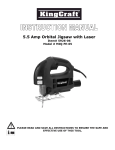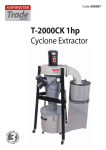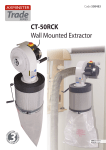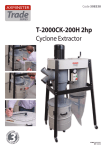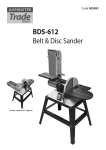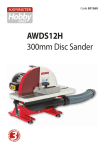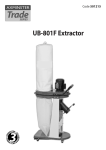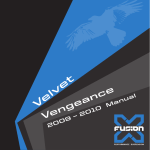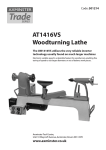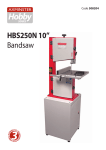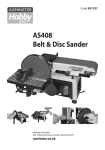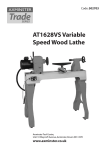Download Axminster SS-12VS Operating instructions
Transcript
Code 501188 SS-12VS 305mm Disc Sander Index of Contents Index of Contents 02 Declaration of Conformity 02 What’s Included 03 General Instructions for 230V Machines 04 Specific to Sanding Machines 05 Specification06 Assembly06-07-08 Setting up 08-09-10 Parts Illustration and Description 11-12 Operating Instructions 13-14 Changing the Abrasive Disc 14-15 Maintenance16 Trouble Shooting 17 Parts Breakdown/List 18-19-20-21 SS-12VS Wiring Diagram 22 Notes23 Declaration of Conformity Manufactured by KINGCRAFT MACHINERY COMPANY LIMITED. is in compliance with the standards determined in the following Council Directive. Copied from CE Certificate The undersigned, N. Sifonios authorised by EN 60204-1:2006+A1: 2009 EN ISO 12100: 2010 KINGCRAFT MACHINERY COMPANY LIMITED. No.26, Gong Yeh 12rd, Dah Li District, Taichung City, Taiwan Low Voltage Directive: 2006/95/EC Machinery Directive: 2006/42/EC Model Number SS-12VS (Disc Sander) Warning Fully read manual and safety instructions before use Ear protection should be worn The symbols below advise that you follow the correct safety procedures when using this machine. Eye protection should be worn 2 Dust mask should be worn HAZARD Motor gets hot What’s Included Quantity Item Part 1 No 1 No 1 No 1 No 1 No SS-12VS Disc Sander Mitre Fence Dust Extraction Adaptor (63mm to 37mm) Dust Extraction Adaptor (63mm to 100mm) Instruction Manual A B C D Model Number SS-12VS Optional Accessories Quantity 1 No Item Stand Part E A Product Code 501189 E C B D Having opened the box, remove the top packaging and lift the machine out and place upon a clear flat surface, taking care not to trap or pinch the power cable under the chassis. Remove the remaining items from the box and place safely aside. Having unpacked your sander and its various components, if you do not wish to retain the packaging please take it to a recycling centre. NOTE: Please read the Instruction Manual prior to using your new machine; as well as the operating procedures for your new machine, there are numerous hints and tips to help you to the machine safely and to maintain its efficiency and prolong its life. Keep this Instruction Manual readily accessible for any others who may also be required to use the machine. 3 General Instructions for 230V Machines the disc, put in a ‘plastic’ bag and store in a warm dry place. With regard to the disc, this advice is on practical if you have upgraded to a Velcro fastening method. Also ensure that spare belts/discs are not stored in damp conditions. Good Working Practices/Safety The following suggestions will enable you to observe good working practices, keep yourself and fellow workers safe and maintain your tools and equipment in good working order. Keep the work area as uncluttered as is practical; this includes personnel as well as material. WARNING! KEEP TOOLS AND EQUIPMENT OUT OF THE REACH OF YOUNG CHILDREN UNDER NO CIRCUMSTANCES SHOULD CHILDREN BE ALLOWED IN WORK AREA Disc Sander Primary Precautions Specific to Sanding Machines These machines are supplied with a moulded 13 Amp. plug and 3 core power cable. Before using the tool inspect the cable and the plug to make sure that neither are damaged. If any damage is visible have the tool inspected/repaired by a suitably qualified person. If it is necessary to replace the plug, it is preferable to use an ‘unbreakable’ type that will resist damage on site. Only use a 13 Amp plug, make sure the cable clamp is tightened securely. Fuse at 13 Amp. It is also good practice to use switched outlets. If extension leads are to be used, carry out the same safety checks on them, and ensure that they are correctly rated to safely supply the current that is required for your machine. This machine is intended primarily for inside/workshop usage. Once the sander is mounted, carry out any setting operations and remove all tools used in the setting operations (if any) and place safely out of the way. If you are working long lengths of material, arrange for extra support beyond the boundary of the machine, and check you have sufficient room to manoeuvre the material through all the operations you will wish to carry out. It is good practice to leave the machine unplugged until work is about to commence; also make sure to unplug the machine when it is not in use. Always disconnect by pulling on the plug body and not the cable. Work Place/Environment After fitting a new sanding disc, it is good practice to lightly sand across the left side of the disc with a reasonable sized (20mm x 50mm) piece of timber to make sure the sanding disc is correctly ‘seated’ on the disc. The sanding action will press the sanding disc firmly back against the disc itself. Always mount the machine on a flat, level stable surface. There are several methods of achieving this; bolting the machine directly to a ‘good solid workbench’; bolting the machine to a sturdy base board that can be clamped to the ‘good solid workbench’; create an independent entity by bolting the machine to its own stand. However you mount your machine, make sure it is secured down and stable before use. DO NOT sand very small pieces of work with bare hands; try to construct some form of holder. Make sure you are comfortable before you start work, balanced, not reaching etc. If the work you are carrying out is liable to generate excessive grit or dust or chips wear the appropriate safety clothing, goggles, masks etc. If the work operation appears to be excessively noisy wear ear-defenders. If you wear your hair in a long style wearing a cap, safety helmet, hair net, even a sweatband, will minimise the possibility of your hair being caught up in the rotating parts of the machine. Likewise, Paper belts and discs do not respond well to wet or damp conditions. In the worst case the adhesives holding the belt and the abrasive fail completely, the belts fall apart and the abrasive becomes a soggy mess against the edge of your workpiece. Try to keep the machine in a reasonably dry, warm environment. If this is not possible, or if the machine is to remain unused for some time, at least remove 4 Specific to Sanding Machines consideration should be given to the removal of rings and wristwatches if these are liable to be a ‘snag’ hazard. Do not press too heavily against the sanding surface, all this will do is slow the sander down. Remember, sanders work by removing small particles of material quickly and heavy pressure works adversely to the cutting process. Further, it will accelerate the rate of ‘clogging’ of the abrasive surfaces, rendering the machine less efficient. Do not work with cutting/abrasive tools of any description if you are tired, your attention is wandering or you are being subjected to distraction. If you are attempting to sand inside curves (over the ‘tracking drum’) do not press at all, other than to keep the workpiece in contact with the surface, any pressure could upset the tracking geometry. As there is no cushioning effect to the belt passing around the drum, expect an added vibration and compensate for it. Do not use the machine within the designated safety areas of flammable liquid stores or in areas where there may be volatile gases. Check that sanding surfaces are still sufficiently abrasive to carry out the work you intend. Sanding belt cleaning sticks are an efficient method of prolonging the life of the belts and discs and will also maintain their operating performance. Sanding of certain types of timber may make the fitting of dust extraction mandatory in order to comply with the directives of the HSE. However, even if it is not mandatory, it is strongly recommended that you consider fitting dust extraction. It will certainly reduce the level of dust and grit, and as it helps to remove the waste quicker will certainly prolong the longevity of the abrasive. Check that the belts or discs are undamaged; torn edges can pick up on the workpiece and will cause the medium to tear, often very rapidly with accompanying sharp flapping edges. Always offer the workpiece to the belt/disc so that the motion carries the work against the restraining surface i.e. the work stop or the table (use the left hand side of the disc). Above all, OBSERVE…. make sure you know what is happening around you, and USE YOUR COMMON SENSE. 5 Specification ModelSS-12VS Product Code 501188 RatingTrade Power 750W (230V, 1ph) Speed 1,000 - 3,000rpm Diameter of Disc 305mm (12") Table Size 300 x 225mm Table Tilt -5° to +45° Dust Extraction Outlet 63mm Overall L x W x H 650 x 400 x 430mm Weight32kg Assembly The disc sander comes fully assembled except the mitre fence (B) and the dust extraction adaptor (C). Please follow the assembly instruction below. Optional Stand Assembly A B Mitre Fence 1 Locate the mitre fence (B) and slide it into the tables ‘T’ slot, see fig 01. 3 Fig 01 4 2 C C B 5 E B 6 D D 1 Dust Extractor Adaptor Locate the dust extractor adaptors (C) or (D), insert it into the 63mm sander outlet. 2 Fig 02 3 C 4 5 6 6 Assembly Step 4 A E B C D X4 M8 Bolts X24 M8 Coach Bolts X32 M8 Washers X28 M8 Nuts X4 Thread Rubber Foot 4 Step 1 3 Step 5 5 1 2 Step 2 E B C Step 6 6 D Step 3 B 7 Continues Over... Assembly Step 7 Step 9 E B C 6 A B C Lower the disc sander on top of the stand and line up the holes, using the four bolt (A) washer (B) and Nuts (C) secure the sander to the stand Step 8 Step 10 Setting up NOTE: Before using your disc sander you need to check that the table is perpendicular by using a 90˚ square. Place a 90˚ square on the sanding disc table, see fig 03 and check that the table is perpendicular to the sanding disc. If it requires adjustment loosen the tilt mechanism clamp (a), see fig 04 and turn the rise and full control knob (b) until the table is at 90˚ to the sanding disc then tighten clamp (a). DO NOT OVERTIGHTEN Fig 03 Table Stops There are two adjusting nuts to the base of each table leg, see fig 05. This is to set the gap between the table and disc. Release the table clamps (c), using a spanner loosen the nuts (d) and adjust the grub 8 Setting up Fig 04 Fig 07 a b Using a square adjust the table until it is set to 90˚ to the disc. Re-tighten the hex bolts. Fig 05 Scale Pointer Now the table is set correctly you may have to adjust the pointer on the scale so it’s set to (0˚) degrees. Loosen the Phillips screw and adjust until correct, re-tighten the screw. (see fig 06) c d Fig 08 e screw stops (e) so the table does not come into contact with the sanding disc, tighten the nuts to lock the table stops in position. Re-tighten the table clamps (c). Table Top Adjustment The table top can be adjusted so it’s square to the sanding disc. Using a Hex key loosen the two Hex bolts in the table, see fig 6. Loosen the Phillips screw and line up the pointer so it reads (0˚) degrees on the scale. Fig 06 Your disc sander is now ready. Check that all fixings are secure before operating the machine. CONNECT THE SANDER TO THE MAINS SUPPLY 9 Continues Over... Setting up Remove all tools away for the machine, Switch on, wait until the machine has reached full speed and check that the disc sander is running properly ie, no vibration or rattling for example. If not, switch off, wait for the machine to come to a complete stop, disconnect the sander and check all fixing to make sure they are tight. Reconnect, switch on and check again. If everything is fine, switch off and wait until the machine has come to a complete stop. Fig 09 DISCONNECT THE SANDER FROM THE MAINS SUPPLY C Dust Extraction The dust extraction moulding has a 63mm outlet, insert a jubilee clip over the general purpose extraction hose and insert it over the outlet and clamp in place. Fig 10 Also the disc sander comes with two adaptors (C) and (D) see figs 09-10. Fit a general purpose hose with either a 37mm or 100mm diameter and with a jubilee clip, secure in place. DO NOT OVERTIGHTEN AS THE EXTRACTION OUTLET IS ONLY PLASTIC AND CAN CRACK IF DONE UP TOO TIGHT. Fig 11 Alternately, if you have a vacuum cleaner with the same diameter hose insert it over the outlet as before, it should be a snug fit. (see fig 11) Vacuum cleaner hose connected to sanders adaptor 10 Parts Illustration and Description Disc guard Sanding Disc Manual disc brake Table Motor Handle Mitre fence Table stop 63mm Dust extraction outlet Control panel Rise and fall control knob Tilt handle lock Table clamp handle a b On/Off NVR switch assembly, (I) on and (O) off 6 AMP OVERLOAD TRIP SWITCH (a) and speed control knob (b) 11 Parts Illustration and Description Tilt mechanism scale c Tilt mechanism scale pointer d Pre-set/Index stops (c) and preset stop pin (d) Table stop adjuster f e Mitre fence scale (e) and pointer (f) Rotating the mitre fence 12 Operating Instructions Rise and Full Control Assembly Pre-set/Index system The table on this sander remains level whilst the whole motor and disc arrangement tilts. This allows your work to stay level, improving accuracy and safety. The disc can be tilted from -5° to + 45°, enabling many tasks to be undertaken. The disc angles are adjusted by a rack and pinion arrangement, plus there is a quick action index system enabling you pre select angles from -5, 0, 15, 22.5, 30 & 45°. The Pre-set/index system enables you to pre select angles from -5, 0, 15, 22.5, 30 & 45°. Tilting the Disc Sander 3. While holding the Index Pin in, tighten the tilt handle lock (a), release the Index Pin. (see fig 15) 1. Unlock the tilt handle lock (a). (see fig 12) 2. Turn the rise and full control knob (b), see fig 13 at the same time pressing in the Index Pin (c), until it engages into one of the pre-set holes (d) in the rack and pinion casting. (see figs 14-15) 1. Unlock the tilt handle lock (a), see fig 12. Fig 14 2. Twist the rise and fall Control knob (b), until you have the correct angle. Then lock the assembly in place with the locking handle (a). (see fig 12-13) d Fig 12 c Fig 15 a Fig 13 b 13 Continues Over... Operating Instructions Variable Disc Speed Fig 17 The motor on this machine is a 750W DC brush type unit, electronically controlled to give a disc speed of between 1,000-3,000rpm. This means that you can choose the disc speed that is right for the job, whatever the material. Disc speed is maintained electronically to compensate for work loads. Manual Disc Brake A manual disc brake is fitted to allow the disc to be stopped quickly if required. (see fig 16) Fig 16 Undo the tables two clamping handles on either side and lower the table Fig 18 Changing the Abrasive Disc DISCONNECT THE SANDER FROM THE MAINS SUPPLY! 1. Release the two clamping handles on either side of the table and lower the table carefully and remove the extraction adaptor, see figs 17-18. Fig 19 2. Loosen the two butterfly screws on either side of the extraction moulding and lower carefully down. (see figs 19-20). (You may need to tilt the sander to lower the extraction moulding fully) 3. Remove the disc guard by undoing and removing the two Phillips screws and place safely aside. (see fig 21) NOTE: BE CAREFUL WHEN REMOVING THE SCREWS AS THERE ARE TWO PLASTIC SPACERS BETWEEN THE DISC GUARD AND THE REAR MOULDING! Undo the two butterfly screws on either side of the disc 14 Changing the Abrasive Disc sanding disc and evenly press down, making sure there are no wrinkles or air bubbles. (see figs 22-23) Fig 20 6. Replace the disc guard, extraction moulding and table. Fig 22 Lower the extraction moulding Fig 21 Peal off the old abrasive disc and place aside Fig 23 Disc guard plastic spacer Offer up the new abrasive disc and press down evenly onto the sanding face WEAR A DUST MASK WHEN CHANGING THE ABRASIVE DISC! 4. The abrasive disc is attached to the sanders face by Velcro, a strip of fabric that cling when pressed together. Simply peal off the old abrasive disc, you may need to use a hand brush to brush off any loose saw dust on the disc face. 5. Line up the new abrasive disc with the face of CONNECT THE SANDER TO THE MAINS SUPPLY! Start up the sander, wait until it’s at full speed and look to see if the abrasive disc is spinning evenly around. If NOT switch off, wait until the sander comes to a complete stop and repeat the procedure from the opposite page until the disc is spinning correctly. 15 Maintenance DISCONNECT THE SANDER FROM THE MAINS SUPPLY! There is very little mechanical maintenance that can be carried out on the machine. Most prudent maintenance is preventative and concerned with keeping the machine clean. WEAR A DUST MASK WHEN CLEANING THE SANDER! Fig 24 1. At reasonable intervals, inspect and remove all dust and resin build up, clean the motor assembly. 2. Lower the dust extraction moulding and remove any dust or resin build up and clean thoroughly. (see fig 24-25) Fig 25 Lower the table Lower the dust extraction moulding and clean any build up of dust or resin 16 Trouble Shooting PROBLEM Motor will not run POSSIBLE CAUSE 1. Defective or broken “ON -OFF” switch REMEDY 1-3. Replace all broken or defective parts before using the sander 2. Defective or damaged switch cord 3. Defective or damaged switch relay 4. Contact Axminster Tool Centre on 03332 406406 and asked to be transferred to the “Technical Enquiries” Department 4. Burned out motor 5. Blown fuse 6. Motor has cut out or stalled 6. Press the 6 AMP OVERLOAD TRIP SWITCH Machine slows down while sanding 1. Applying too much pressure to workpiece 1. Apply less pressure to sanding surface Wood burns while sanding 1. Sanding disc is worn 1. Replace the disc 2. Excessive pressure being applied to workpiece 2. Reduce pressure being applied to workpiece 6 AMP OVERLOAD TRIP SWITCH Above the speed control dial there is a “6 AMP OVERLOAD TRIP SWITCH”. If the sander stalls from too much pressure being applied to the disc or the motor cuts out due to overheating or over use, press this switch to reset the sander. (see fig 26) NOTE: WAIT TWO MINUTES AFTER THE SANDER HAS STOPPED BEFORE PRESSING THE OVERLOAD TRIP SWITCH TO ALLOW THE COMPONENTS TO COOL DOWN! Fig 26 6 AMP OVERLOAD TRIP SWITCH 17 Parts Breakdown/List 18 Parts Breakdown/List NO. Description Specification QTY 1 Front cover 2 Knob 1/4” 2 3 Sanding Disc 12”-#80 1 3-1 Velcro paper 4 Flat HD Screw 1/4-20UNCX1/2” 11 5 Washer 1/4”-24 1 6 Disc Plate 12” 1 7 Hex Head Screw 1/4”X1/2” 6 8 Hex Socket Round HD Screw 1/4”-1/2” 7 9 Cap Screw M4X55 1 10 Disc Tray 11 Nut 12 Brake Wagon 1 13 Brake Plate 1 14 Fixing Plate 1 15 Flat HD Screw 16 Brake Pin 1 17 Spring 1 18 Button 1 19 Motor Support 1 20 Motor 1 23 Hex Head Screw 24 Worktable 25 Cap Screw 5/16”-1” 2 26 Universal Handle 1/4” 1 27 Washer 1/4”-T=3MM 2 28 Knob 1 29 Hexagonal Rod 1 30 Index Pin 1 31 Spring 1 32 Sleeve 1 33 E-Ring 1 1 1 3/16” 3/16”X3/8” 1/4X1” 5 8 2 1 ETW-3 19 1 Parts Breakdown/List 34 Hex Socket Round HD Screw 1/4”X1” 4 35 Washer 4 36 Gear 2 37 Clamping Plate 2 38 Guide Block(R) 1 38B Guide Block(l) 39 Washer 40 Angle Gauge Plate 40B Angle Gauge Plate 41 Universal Handle 3/8” 2 42 Washer 3/8” 4 43 Rod 2 44 Bracket 1 1 1/4” 8 1 1 45 Nut 47 Control Panel M8 1 48 Base 1 49 Strain Relief 50 Plate 51 Coil Spring 52 Main Switch 1 53 Power Cord 1 54 Pressure Plate 1 55 Nut 1 56 Round HD Cross Screw 57 Circuit Board 1 58 Insulating Film 1 59 Heat Sinks 1 60 Cheese Head Screw 5/16”x3/4” 1 61 Cheese Head Screw M4X12nn 1 62 Knob 1 63 VR 1 64 Circuit Breaker 1 65 Wire-Short 1 PG9 2 2 1 1/4” M3X12mm 20 11 6 Parts Breakdown/List 66 Insulating Paper 1 67 Space Block 4 68 Bottom Plate 69 Tooth Washer 70 Warning Label 71 Tapping Screw 72 Space Block 2 73 Safety Plate 1 74 Warning Label 75 Dust Chute 76 I.D. Label 1 77 Warning Label 1 78 Carry Handle 2 79 Key 6x6X25 1 80 Nut M3 4 82 Dust Chute 2-1/4” to 4” 1 83 Guide Bush 84 Nylon Nut M4 1 85 Set Screw 1/4”x35mm 2 86 Nut 1/4” 2 87 Cheese Head Screw 3/16”x1/2” 4 90 Washer M4 1 91 Pointer 92 Circuit Board 93 Angle Guide 1 94 Rod 1 95 Motor Label 1 96 Hex Screw 3/8”-2” 4 97 Nut 3/8” 2 1 3/16” 2 1 3/16”X1” 2 1 2-1/4” to1-1/2” 1 1 1 M4X5 21 1 SS-12VS Wiring Diagram 22 Notes 23 The Axminster guarantee is avalible on Hobby, Trade, Industrial, Engineer, Air Tool & Axcnc Technology Series machines It’s probably the most comprehensive FREE guarantee ever- buy with confidence from Axminster! So sure are we of the quality, we cover all parts and labour free of charge for three years! • Look for the icon and put your trust in Axminster • No registration necessary - just keep your proof of purchase • Optional Service Plan for Industrial Series machinery Great value & easy-to-use, perfect for use at home Solid, reliable machines designed for daily use Top performers with class leading features and build quality for use in busy workshops Quality, precision machines for the workshop or education Small machines for the home engineer Compressors and tools for home or workshop use, duable and great value Free Three Year Guarantee on Axminster Hobby, Trade and Industrial Series woodworking and engineering machines, Axminster Air compressors and Air Tools, and bench top grinders - no registration necessary just proof of purchase. We will repair or replace at our discretion and will collect only from a UK mainland address, irrespective of the original delivery address The Guarantee assumes that you have bought the correct machine for the required operation, in accordance with our guidelines; have operated and maintained it in accordance with the instruction manual; and that all cutting machines will be used with a blade which is sharp and serviceable at all times. It does not cover consumable items purchased with the original product, including original blades or abrasives Pecision CNC machines for industry and education Normal wear and tear, misuse, abuse and neglect are excluded and the machine should not have been modified in any way. Please do not attempt to service the product without first contacting us; we are happy to guide you but failure to do so may invalidate the guarantee The Guarantee is transferrable from owner to owner in the first three years but you must have original proof of purchase. Should we need to replace a machine in the first three years the guarantee will still continue to be effective from the original purchase date Full Terms and Conditions can be found here. This guarantee does not affect your statutory rights. for more information visit axminster.co.uk/3years Please dispose of packaging for the product in a responsible manner. It is suitable for recycling. Help to protect the environment, take the packaging to the local recycling centre and place into the appropriate recycling bin. Only for EU countries Do not dispose of electric tools together with household waste material. In observance of European Directive 2002/96/EC on waste electrical and electronic equipment and its implementation in accordance with national law, electric tools that have reached the end of their life must be collected separately and returned to an environmentally compatible recycling facility. Axminster Tool Centre, Unit 10 Weycroft Avenue, Axminster, Devon EX13 5PH axminster.co.uk
























